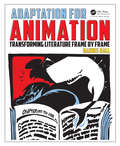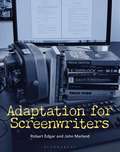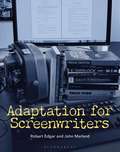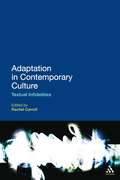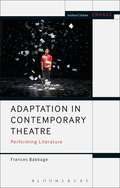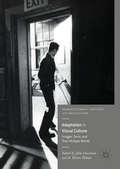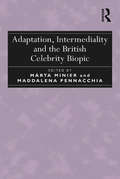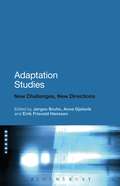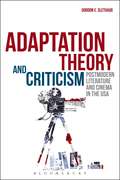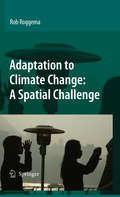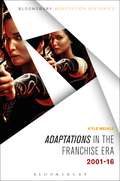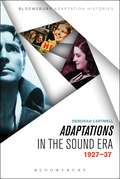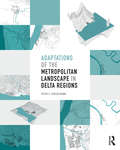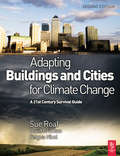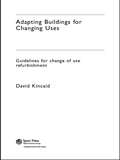- Table View
- List View
Adaptation for Animation: Transforming Literature Frame by Frame
by Hannes RallTalented animation artists often neglect successful storytelling in favor of strong visuals, but now you can have both with this complete guide to adaptation for animation. Veteran independent filmmaker Hannes Rall teaches you how to draw and adapt inspiration from copyright-free materials like fairy tales, myths, and classic literature, making it easier than ever to create your own compelling narrative. Particular focus is given to making the adequate narrative and visual choices when transferring a text from page to screen: How to create a successful adaptation. With sections on subjects like transcultural adaptations, visual poetry and production design, this book is just the right mix of practical advice, lavish illustrations, and industry case studies to give you everything you need to start adapting your story today. Key features: Learn to apply concepts of adapting classic and modern literature for animation in different techniques Exclusive interviews with animation legends Giannalberto Bendazzi, John Canemaker, Ishu Patel and Georges Schwizgebel Lavishly illustrated with 325 color images (mostly never published before) that give thrilling insights into the visual development of award-winning animated adaptations
Adaptation for Screenwriters
by Robert Edgar John MarlandDevelop the critical and creative skills to 'translate' a story from page to screen with this step-by-step guide to the process of screen adaptation you'll learn to:- interrogate a novel or short story to release its 'inner film'- convert fictional prose into visual drama- overcome the obstacles presented by different media 'languages'- approach key strategic decisions - both technical and interpretive- draft and re-draft your plot, characters and dialogue- professionally format and submit your finished scriptIn addition to examples taken from 'literary classics', contemporary novels, genre fiction, short stories, and biographical material, Marland and Edgar embrace the wider phenomenon of re-telling and updating existing stories, such as the 'appropriation' of popular figures, inter-film adaptation (sequels and 'reboots'), and development into other visual forms including graphic fiction and video games.Whether you are producing a faithful adaptation of Tolstoy's War and Peace, or planning to pair up the crime-fighting duo of Sherlock Holmes and Batman, Adaptation for Screenwriters will be your guide.
Adaptation for Screenwriters
by Robert Edgar John MarlandDevelop the critical and creative skills to 'translate' a story from page to screen with this step-by-step guide to the process of screen adaptation you'll learn to:- interrogate a novel or short story to release its 'inner film'- convert fictional prose into visual drama- overcome the obstacles presented by different media 'languages'- approach key strategic decisions - both technical and interpretive- draft and re-draft your plot, characters and dialogue- professionally format and submit your finished scriptIn addition to examples taken from 'literary classics', contemporary novels, genre fiction, short stories, and biographical material, Marland and Edgar embrace the wider phenomenon of re-telling and updating existing stories, such as the 'appropriation' of popular figures, inter-film adaptation (sequels and 'reboots'), and development into other visual forms including graphic fiction and video games.Whether you are producing a faithful adaptation of Tolstoy's War and Peace, or planning to pair up the crime-fighting duo of Sherlock Holmes and Batman, Adaptation for Screenwriters will be your guide.
Adaptation in Contemporary Culture: Textual Infidelities
by Rachel CarrollAdaptation in Contemporary Culture: Textual Infidelities seeks to reconfigure the ways in which adaptation is conceptualised by considering adaptation within an extended range of generic, critical and theoretical contexts. This collection explores literary, film, television and other visual texts both as 'origins' and 'adaptations' and offers new insights into the construction of genres, canons and 'classics'. Chapters investigate both 'classic' and contemporary texts by British and American authors, from Jane Austen, Edgar Allen Poe and Charles Dickens to Bret Easton Ellis, P.D James and Sarah Waters. A diverse range of literary, film and television genres is examined, from romance to science fiction, the Western to the 'women's picture' and the heritage film to postmodern pastiche. With a thematic focus on key critical paradigms for adaptation studies - fidelity, intertextuality, historicity and authorship - this collection expands the field of adaptation studies beyond its conventional focus on 'page to screen' adaptations to include film remakes, video games, biopics, fan fiction and celebrity culture.
Adaptation in Contemporary Theatre: Performing Literature (Methuen Drama Engage)
by Frances BabbageWhy are so many theatre productions adaptations of one kind or another? Why do contemporary practitioners turn so frequently to non-dramatic texts for inspiration? This study explores the fascination of novels, short stories, children's books and autobiographies for theatre makers and examines what 'becomes' of literary texts when these are filtered into contemporary practice that includes physical theatre, multimedia performance, puppetry, immersive and site-specific performance and live art.In Adaptation in Contemporary Theatre, Frances Babbage offers a series of fresh critical perspectives on the theory of adaptation in theatre-making, focusing on meditations of prose literature within contemporary performance. Individual chapters explore the significance and impact of books as physical objects within productions; the relationship between the dramatic adaptation and literary edition; storytelling on the page and in performance; literary space and theatrical space; and prose fiction reframed as 'found text' in contemporary theatre and live art. Case studies are drawn from internationally acclaimed companies including Complicite, Elevator Repair Service, Kneehigh, Forced Entertainment, Gob Squad, Teatro Kismet and Stan's Cafe.Adaptation in Contemporary Theatre is a compelling and provocative resource for anyone interested in the potential and the challenges of using prose literature as material for new theatrical performance.
Adaptation in Contemporary Theatre: Performing Literature (Methuen Drama Engage)
by Frances BabbageWhy are so many theatre productions adaptations of one kind or another? Why do contemporary practitioners turn so frequently to non-dramatic texts for inspiration? This study explores the fascination of novels, short stories, children's books and autobiographies for theatre makers and examines what 'becomes' of literary texts when these are filtered into contemporary practice that includes physical theatre, multimedia performance, puppetry, immersive and site-specific performance and live art.In Adaptation in Contemporary Theatre, Frances Babbage offers a series of fresh critical perspectives on the theory of adaptation in theatre-making, focusing on meditations of prose literature within contemporary performance. Individual chapters explore the significance and impact of books as physical objects within productions; the relationship between the dramatic adaptation and literary edition; storytelling on the page and in performance; literary space and theatrical space; and prose fiction reframed as 'found text' in contemporary theatre and live art. Case studies are drawn from internationally acclaimed companies including Complicite, Elevator Repair Service, Kneehigh, Forced Entertainment, Gob Squad, Teatro Kismet and Stan's Cafe.Adaptation in Contemporary Theatre is a compelling and provocative resource for anyone interested in the potential and the challenges of using prose literature as material for new theatrical performance.
Adaptation in Visual Culture: Images, Texts, and Their Multiple Worlds
by Julie Grossman R. Barton PalmerThis book gathers together essays written by leading scholars of adaptation studies to explore the full range of practices and issues currently of concern in the field. The chapters demonstrate how content and messaging are shared across an increasing number of platforms, whose interrelationships have become as intriguing as they are complex. Recognizing that a signature feature of contemporary culture is the convergence of different forms of media, the contributors of this book argue that adaptation studies has emerged as a key discipline that, unlike traditional literary and art criticism, is capable of identifying and analyzing the relations between source texts and adaptations created from them. Adaptation scholars have come to understand that these relations not only play out in individual case histories but are also institutional, and this collection shows how adaptation plays a key role in the functioning of cinema, television, art, and print media. The volume is essential reading for all those interested both in adaptation studies and also in the complex forms of intermediality that define contemporary culture in the 21st century.
Adaptation in Visual Culture: Images, Texts, and Their Multiple Worlds
by Julie Grossman R. Barton PalmerThis book gathers together essays written by leading scholars of adaptation studies to explore the full range of practices and issues currently of concern in the field. The chapters demonstrate how content and messaging are shared across an increasing number of platforms, whose interrelationships have become as intriguing as they are complex. Recognizing that a signature feature of contemporary culture is the convergence of different forms of media, the contributors of this book argue that adaptation studies has emerged as a key discipline that, unlike traditional literary and art criticism, is capable of identifying and analyzing the relations between source texts and adaptations created from them. Adaptation scholars have come to understand that these relations not only play out in individual case histories but are also institutional, and this collection shows how adaptation plays a key role in the functioning of cinema, television, art, and print media. The volume is essential reading for all those interested both in adaptation studies and also in the complex forms of intermediality that define contemporary culture in the 21st century.
Adaptation, Intermediality and the British Celebrity Biopic
by Márta Minier Maddalena PennacchiaBeginning with the premise that the biopic is a form of adaptation and an example of intermediality, this collection examines the multiplicity of 'source texts' and the convergence of different media in this genre, alongside the concurrent issues of fidelity and authenticity that accompany this form. The contributors focus on big and small screen biopics of British celebrities from the late twentieth and twenty-first centuries, attending to their myth-making and myth-breaking potential. Related topics are the contemporary British biopic's participation in the production and consumption of celebrated lives, and the biopic's generic fluidity and hybridity as evidenced in its relationship to such forms as the bio-docudrama. Offering case studies of film biographies of literary and cultural icons, including Elizabeth I, Elizabeth II, Diana Princess of Wales, John Lennon, Shakespeare, Jane Austen, Beau Brummel, Carrington and Beatrix Potter, the essays address how British identity and heritage are interrogated in the (re)telling and showing of these lives, and how the reimagining of famous lives for the screen is influenced by recent processes of manufacturing celebrity.
Adaptation, Intermediality and the British Celebrity Biopic
by Márta Minier Maddalena PennacchiaBeginning with the premise that the biopic is a form of adaptation and an example of intermediality, this collection examines the multiplicity of 'source texts' and the convergence of different media in this genre, alongside the concurrent issues of fidelity and authenticity that accompany this form. The contributors focus on big and small screen biopics of British celebrities from the late twentieth and twenty-first centuries, attending to their myth-making and myth-breaking potential. Related topics are the contemporary British biopic's participation in the production and consumption of celebrated lives, and the biopic's generic fluidity and hybridity as evidenced in its relationship to such forms as the bio-docudrama. Offering case studies of film biographies of literary and cultural icons, including Elizabeth I, Elizabeth II, Diana Princess of Wales, John Lennon, Shakespeare, Jane Austen, Beau Brummel, Carrington and Beatrix Potter, the essays address how British identity and heritage are interrogated in the (re)telling and showing of these lives, and how the reimagining of famous lives for the screen is influenced by recent processes of manufacturing celebrity.
Adaptation Studies: New Challenges, New Directions
by Jorgen Bruhn Anne Gjelsvik Eirik Frisvold HanssenExtending the boundaries of contemporary adaptation studies, this book brings together leading international scholars to survey new directions in the field. Re-thinking the key questions at the heart of the discipline, Adaptation Studies: New Challenges, New Directions explores a wide range of perspectives and case studies in cross-media transformation. Topics covered include: * The history of adaptation studies * Theories of adaptation * Adaptations in film, literature, radio and historical sources * What is an 'original' text?
Adaptation Studies: New Challenges, New Directions
by Edited by Jørgen Bruhn, Anne Gjelsvik and Eirik Frisvold HanssenExtending the boundaries of contemporary adaptation studies, this book brings together leading international scholars to survey new directions in the field. Re-thinking the key questions at the heart of the discipline, Adaptation Studies: New Challenges, New Directions explores a wide range of perspectives and case studies in cross-media transformation. Topics covered include: * The history of adaptation studies * Theories of adaptation * Adaptations in film, literature, radio and historical sources * What is an 'original' text?
Adaptation Theory and Criticism: Postmodern Literature and Cinema in the USA
by Gordon E. SlethaugTraditional critics of film adaptation generally assumed a) that the written text is better than the film adaptation because the plot is more intricate and the language richer when pictorial images do not intrude; b) that films are better when particularly faithful to the original; c) that authors do not make good script writers and should not sully their imagination by writing film scripts; d) and often that American films lack the complexity of authored texts because they are sourced out of Hollywood. The 'faithfulness' view has by and large disappeared, and intertextuality is now a generally received notion, but the field still lacks studies with a postmodern methodology and lens.Exploring Hollywood feature films as well as small studio productions, Adaptation Theory and Criticism explores the intertextuality of a dozen films through a series of case studies introduced through discussions of postmodern methodology and practice. Providing the reader with informative background on theories of film adaptation as well as carefully articulated postmodern methodology and issues, Gordon Slethaug includes several case studies of major Hollywood productions and small studio films, some of which have been discussed before (Age of Innocence, Gangs of New York, and Do the Right Thing) and some that have received lesser consideration (Six Degrees of Separation, Smoke, Smoke Signals, Broken Flowers, and various Snow White narratives including Enchanted, Mirror Mirror, and Snow White and the Huntsman). Useful for both film and literary studies students, Adaptation Theory and Criticism cogently combines the existing scholarship and uses previous theories to engage readers to think about the current state of American literature and film.
Adaptation Theory and Criticism: Postmodern Literature and Cinema in the USA
by Gordon E. SlethaugTraditional critics of film adaptation generally assumed a) that the written text is better than the film adaptation because the plot is more intricate and the language richer when pictorial images do not intrude; b) that films are better when particularly faithful to the original; c) that authors do not make good script writers and should not sully their imagination by writing film scripts; d) and often that American films lack the complexity of authored texts because they are sourced out of Hollywood. The 'faithfulness' view has by and large disappeared, and intertextuality is now a generally received notion, but the field still lacks studies with a postmodern methodology and lens.Exploring Hollywood feature films as well as small studio productions, Adaptation Theory and Criticism explores the intertextuality of a dozen films through a series of case studies introduced through discussions of postmodern methodology and practice. Providing the reader with informative background on theories of film adaptation as well as carefully articulated postmodern methodology and issues, Gordon Slethaug includes several case studies of major Hollywood productions and small studio films, some of which have been discussed before (Age of Innocence, Gangs of New York, and Do the Right Thing) and some that have received lesser consideration (Six Degrees of Separation, Smoke, Smoke Signals, Broken Flowers, and various Snow White narratives including Enchanted, Mirror Mirror, and Snow White and the Huntsman). Useful for both film and literary studies students, Adaptation Theory and Criticism cogently combines the existing scholarship and uses previous theories to engage readers to think about the current state of American literature and film.
Adaptation to Climate Change: A Spatial Challenge
by Rob RoggemaAs it becomes clear that climate change is not easily within the boundaries of the 1990’s, society needs to be prepared and needs to anticipate future changes due to the uncertain changes in climate. So far, extensive research has been carried out on several issues including the coastal defence or shifting ecozones. However, the role spatial design and planning can play in adapting to climate change has not yet been focused on. This book illuminates the way adaptation to climate change is tackled in water management, ecology, coastal defence, the urban environment and energy. The question posed is how each sector can anticipate climate change by creating spatial designs and plans. The main message of this book is that spatial design and planning are a very useful tool in adapting to climate change. It offers an integral view on the issue, it is capable in dealing with uncertainties and it opens the way to creative and anticipative solutions. Dealing with adaptation to climate change requires a shift in mindset; from a technical rational way of thinking towards an integral proactive one. A new era in spatial design and planning looms on the horizon.
Adaptations in the Franchise Era: 2001-16 (Bloomsbury Adaptation Histories)
by Kyle MeikleAdaptations in the Franchise Era re-evaluates adaptation's place in a popular culture marked by the movement of content and audiences across more media borders than ever before. While adaptation has historically been understood as the transfer of stories from one medium to another-more often than not, from novel to film-the growing interconnectedness of media and media industries in the early twenty-first century raises new questions about the form and function of adaptation as both a product and a process. Where does adaptation fit within massive franchises that span pages, stages, screens, and theme parks? Rising scholar Kyle Meikle illuminates adaptation's enduring and essential role in the rise of franchises in the 2000s and 2010s. During that decade-and-a-half, adaptations set the foundation for multiplexed, multiplied film series, piloted streaming television's forays into original programming, found their way into audiences' hands in apps and video games, and went live in theatrical experiences on Broadway and beyond. The proliferation of adaptations was matched only by a proliferation of adaptation, as fans remixed and remade their favourite franchises online and off-. This volume considers how producers and consumers defined adaptations-and how adaptations defined themselves-through the endless intertextual play of the franchise era.
Adaptations in the Franchise Era: 2001-16 (Bloomsbury Adaptation Histories)
by Kyle MeikleAdaptations in the Franchise Era re-evaluates adaptation's place in a popular culture marked by the movement of content and audiences across more media borders than ever before. While adaptation has historically been understood as the transfer of stories from one medium to another-more often than not, from novel to film-the growing interconnectedness of media and media industries in the early twenty-first century raises new questions about the form and function of adaptation as both a product and a process. Where does adaptation fit within massive franchises that span pages, stages, screens, and theme parks? Rising scholar Kyle Meikle illuminates adaptation's enduring and essential role in the rise of franchises in the 2000s and 2010s. During that decade-and-a-half, adaptations set the foundation for multiplexed, multiplied film series, piloted streaming television's forays into original programming, found their way into audiences' hands in apps and video games, and went live in theatrical experiences on Broadway and beyond. The proliferation of adaptations was matched only by a proliferation of adaptation, as fans remixed and remade their favourite franchises online and off-. This volume considers how producers and consumers defined adaptations-and how adaptations defined themselves-through the endless intertextual play of the franchise era.
Adaptations in the Sound Era: 1927-37 (Bloomsbury Adaptation Histories)
by Deborah CartmellThere is no disputing that the coming of sound heralded a new era for adaptations. We take it for granted today that a film is enhanced by sound but it was not a view unanimously held in the early period of sound cinema. While there was a substantial degree of skepticism in the late 1920s and early 30s about the advantages of sound, what we would call technophobia today, the inclusion of speech in screen versions of literary and theatrical works, undeniably revised what it was to be an adaptation: words. Focusing on promotional materials, Adaptations in the Sound Era tracks early attempts to promote sound through the elevation of words in adaptations in the early sound period. The popular appeal of these films clearly stands in opposition to academic regard for them and the book reflects on the presence and marketing of 'words' in a variety of adaptations, from the introduction of sound in the late 1920s to the mid 1930s. This book contextualizes a range of adaptations in relation to debates about 'picturizations' of books in the early sound era, including reactions to the talking adaptation by writers such as, Irwin Panofsky, Aldous Huxley and Graham Greene. Film adaptations of Shakespeare, Dickens, gothic fiction and biopics are also discussed in relation to their use and promotion of sound or, more precisely, words.
Adaptations in the Sound Era: 1927-37 (Bloomsbury Adaptation Histories)
by Deborah CartmellThere is no disputing that the coming of sound heralded a new era for adaptations. We take it for granted today that a film is enhanced by sound but it was not a view unanimously held in the early period of sound cinema. While there was a substantial degree of skepticism in the late 1920s and early 30s about the advantages of sound, what we would call technophobia today, the inclusion of speech in screen versions of literary and theatrical works, undeniably revised what it was to be an adaptation: words. Focusing on promotional materials, Adaptations in the Sound Era tracks early attempts to promote sound through the elevation of words in adaptations in the early sound period. The popular appeal of these films clearly stands in opposition to academic regard for them and the book reflects on the presence and marketing of 'words' in a variety of adaptations, from the introduction of sound in the late 1920s to the mid 1930s. This book contextualizes a range of adaptations in relation to debates about 'picturizations' of books in the early sound era, including reactions to the talking adaptation by writers such as, Irwin Panofsky, Aldous Huxley and Graham Greene. Film adaptations of Shakespeare, Dickens, gothic fiction and biopics are also discussed in relation to their use and promotion of sound or, more precisely, words.
Adaptations of the Metropolitan Landscape in Delta Regions
by Peter C BosselmannAdaptations of the Metropolitan Landscape in Delta Regions is about environmental quality and the long term livability of urban areas. In decades to come, climate change will affect cities everywhere, but nowhere have the effects of climate change already been felt as strongly as in low-lying coastal cities, cities located in large river deltas and near tidal estuaries. This book reflects on the contribution that spatial planning and urban design can make to a complex discussion about how city form and landscapes will need to adapt within metropolitan areas. The book’s focus is on the urban form of three delta regions: the Pearl River Delta in Southern China; the Rhine, Maas, and Scheldt Delta in the Netherlands; and the San Francisco Bay Area in Northern California. The three regions differ greatly, but despite their different political systems, history, culture and locations in three different climate zones, all three regions will be forced to respond to similar issues that will trigger transformations and adaptations to their urban form. Richly illustrated in color with detailed diagrams, models, photographs and sketches, the book is written for students, scholars and practitioners of environmental planning, and designers who need to respond to the future form of cities in light of climate change. For the professions shaping the physical world of cities and regions, the challenge is not only one of designing physical geometries but of social consequences.
Adaptations of the Metropolitan Landscape in Delta Regions
by Peter C BosselmannAdaptations of the Metropolitan Landscape in Delta Regions is about environmental quality and the long term livability of urban areas. In decades to come, climate change will affect cities everywhere, but nowhere have the effects of climate change already been felt as strongly as in low-lying coastal cities, cities located in large river deltas and near tidal estuaries. This book reflects on the contribution that spatial planning and urban design can make to a complex discussion about how city form and landscapes will need to adapt within metropolitan areas. The book’s focus is on the urban form of three delta regions: the Pearl River Delta in Southern China; the Rhine, Maas, and Scheldt Delta in the Netherlands; and the San Francisco Bay Area in Northern California. The three regions differ greatly, but despite their different political systems, history, culture and locations in three different climate zones, all three regions will be forced to respond to similar issues that will trigger transformations and adaptations to their urban form. Richly illustrated in color with detailed diagrams, models, photographs and sketches, the book is written for students, scholars and practitioners of environmental planning, and designers who need to respond to the future form of cities in light of climate change. For the professions shaping the physical world of cities and regions, the challenge is not only one of designing physical geometries but of social consequences.
Adapting Buildings and Cities for Climate Change
by David Crichton Fergus Nicol Sue RoafFrom the bestselling author of Ecohouse, this fully revised edition of Adapting Buildings and Cities for Climate Change provides unique insights into how we can protect our buildings, cities, infra-structures and lifestyles against risks associated with extreme weather and related social, economic and energy events. Three new chapters present evidence of escalating rates of environmental change. The authors explore the growing urgency for mitigation and adaptation responses that deal with the resulting challenges. Theoretical information sits alongside practical design guidelines, so architects, designers and planners can not only see clearly what problems they face, but also find the solutions they need, in order to respond to power and water supply needs. Considers use of materials, structures, site issues and planning in order to provide design solutions. Examines recent climate events in the US and UK and looks at how architecture was successful or not in preventing building damage. Adapting Buildings and Cities for Climate Change is an essential source, not just for architects, engineers and planners facing the challenges of designing our building for a changing climate, but also for everyone involved in their production and use.
Adapting Buildings and Cities for Climate Change: A 21st Century Survival Guide
by David Crichton Fergus Nicol Sue RoafFrom the bestselling author of Ecohouse, this fully revised edition of Adapting Buildings and Cities for Climate Change provides unique insights into how we can protect our buildings, cities, infra-structures and lifestyles against risks associated with extreme weather and related social, economic and energy events. Three new chapters present evidence of escalating rates of environmental change. The authors explore the growing urgency for mitigation and adaptation responses that deal with the resulting challenges. Theoretical information sits alongside practical design guidelines, so architects, designers and planners can not only see clearly what problems they face, but also find the solutions they need, in order to respond to power and water supply needs. Considers use of materials, structures, site issues and planning in order to provide design solutions. Examines recent climate events in the US and UK and looks at how architecture was successful or not in preventing building damage. Adapting Buildings and Cities for Climate Change is an essential source, not just for architects, engineers and planners facing the challenges of designing our building for a changing climate, but also for everyone involved in their production and use.
Adapting Buildings for Changing Uses: Guidelines for Change of Use Refurbishment
by David KincaidAdapting Building for Changing Uses discusses the comprehensive refurbishment of buildings to enable them to be used for purposes different to those originally intended.For those involved in the often risky business of conversion of buildings from one type of use to another, Adapting Building for Changing Uses provides secure guidance on which uses may be best suited to a particular location. This guidance is based on a unique decision tool, the "Use Comparator", which was developed through research carried out at UCL in the mid 1990's. The "Use Comparator" compares the physical and locational characteristics of a building with the characteristics best suited to various types of use. A total of 77 targeted types of use are evaluated, in contrast to the 17 uses normally considers by regulatory planners.Adapting Building for Changing Uses also identifies the key problems experienced by building managers involved in assembling the coalition of Producers, Investors, Marketeers, Regulators and Users, which makes the key decisions in "Adaptive Reuse". The book explores the differing perceptions and attitudes of these key decision agents to matters such as cost, value, risk and robustness, and offers advice on how to avoid the potential for project failure that these differences present.
Adapting Buildings for Changing Uses: Guidelines for Change of Use Refurbishment
by David KincaidAdapting Building for Changing Uses discusses the comprehensive refurbishment of buildings to enable them to be used for purposes different to those originally intended.For those involved in the often risky business of conversion of buildings from one type of use to another, Adapting Building for Changing Uses provides secure guidance on which uses may be best suited to a particular location. This guidance is based on a unique decision tool, the "Use Comparator", which was developed through research carried out at UCL in the mid 1990's. The "Use Comparator" compares the physical and locational characteristics of a building with the characteristics best suited to various types of use. A total of 77 targeted types of use are evaluated, in contrast to the 17 uses normally considers by regulatory planners.Adapting Building for Changing Uses also identifies the key problems experienced by building managers involved in assembling the coalition of Producers, Investors, Marketeers, Regulators and Users, which makes the key decisions in "Adaptive Reuse". The book explores the differing perceptions and attitudes of these key decision agents to matters such as cost, value, risk and robustness, and offers advice on how to avoid the potential for project failure that these differences present.
